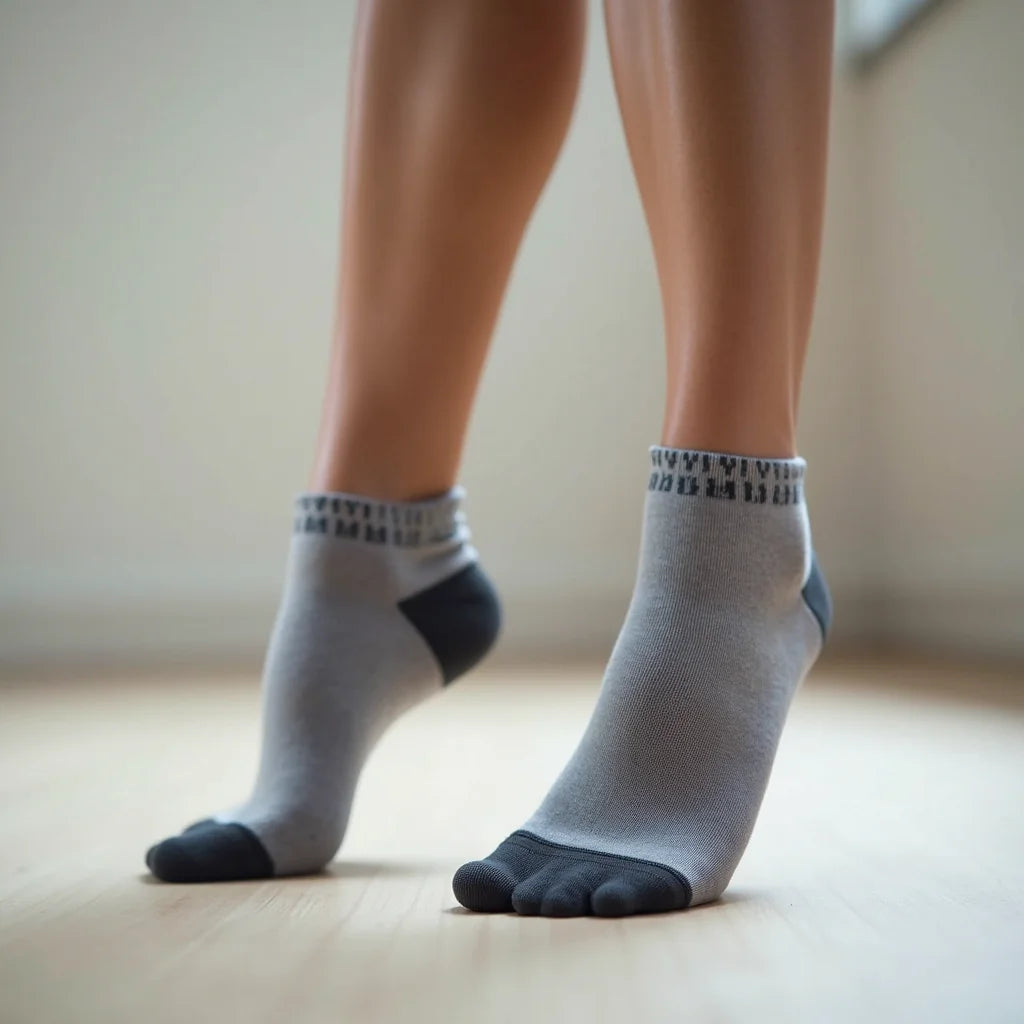Updated on: 2025-08-29
Pilates Grip Socks: Table of Contents
- Pilates Grip Socks: What They Are and Why They Matter
- Essential Tips for Non-Slip Pilates Socks
- Step-by-Step: How to Choose, Wear, and Care for Pilates Grip Socks
- Summary and Takeaway on Pilates Grip Socks
- Pilates Grip Socks Q&A
- About the Author: Pilates Grip Socks Insights
Pilates Grip Socks: What They Are and Why They Matter
Pilates grip socks are purpose-built socks with silicone or rubberized traction on the sole to reduce slipping during movement. Whether you’re on a reformer carriage or a studio floor, non-slip pilates socks stabilize your stance, sharpen control, and protect hygiene in shared spaces. If you’ve ever wondered whether grip socks for pilates can elevate your practice, the short answer is yes—they help you hold form longer, flow with confidence, and minimize distractions caused by sliding feet.
Beyond pilates, these socks cross over into yoga and barre. Many athletes use yoga grip socks for standing poses, balance work, and transitions. Barre socks add security during pulses, relevés, and turnout drills. The best pilates grip socks for reformer classes combine firm traction with breathable materials and a snug fit, so your foot feels anchored without feeling squeezed.
When to use grip socks for Pilates, yoga, and barre
- Reformer classes: Keep feet planted on the footbar or carriage while you press, pull, and flow.
- Mat pilates: Stabilize planks, side kicks, and teaser variations on hardwood or studio floors.
- Yoga: Add traction to warrior transitions, lunges, and standing balance without committing to shoes.
- Barre: Support turnout and small-range movements without losing footing.
Customer testimonials on non-slip performance
“I used to slide on the reformer. With grip socks, my foot stays locked in so I can focus on my alignment.” — Maya, reformer enthusiast
“I love the arch support—feels secure without being tight. Perfect for barre and pilates days.” — Leo, studio regular
Essential Tips for Non-Slip Pilates Socks
- Match the grip to your surface: Heavier dots or full-sole grips perform best on slick studio floors and smooth carriage decks.
- Prioritize a snug heel: A secure heel cup stops the sock from twisting mid-movement, especially during lunges and footbar presses.
- Choose breathable, soft fibers: Look for cotton blends that manage heat yet hold shape class after class.
- Consider pilates grip socks with toe separators and arch support: Toe separation can improve splay and alignment; gentle arch bands help the sock stay put during dynamic series.
- Keep the grips clean: Dust and lint reduce traction. Wipe the soles before class and follow wash instructions to maintain stickiness.
- Own at least two pairs: Rotate between sessions so fibers rebound and grips dry fully.
- Think crossover: Yoga grip socks and barre socks can double for pilates; pick a neutral color that pairs with your studio gear.
- Pack a spare: A backup pair saves your session if one goes missing or gets damp.
Step-by-Step: How to Choose, Wear, and Care for Pilates Grip Socks
Step 1: Confirm your studio policy
Check whether your studio requires pilates grip socks for reformer classes. Many do, for safety and cleanliness. If it’s optional, consider them an easy upgrade for traction and confidence.
Step 2: Choose the grip pattern and coverage
Look at the sole. Full-coverage dots or patterns offer strong traction on smooth decks. Partial coverage can feel lighter for mat work. If you’re unsure, pick full-sole grips—reliable across reformer, mat, and barre.
Step 3: Fit, toe separators, and arch support
Fit should be snug from toe to heel without compression marks. If your toes like room to spread, consider pilates grip socks with toe separators and arch support. Toe separators can enhance contact area, and a supportive arch band helps prevent mid-class slippage.
Looking for an easy, studio-ready option? Explore the Beige ankle grip socks multi-pack for a neutral, wear-with-anything look and reliable traction: Antislips Grip Sock - Ankle - Beige - 3 pair pack.

Step 4: Test traction at home
Before class, try a few lunges, planks, and calf raises on a smooth surface. Your foot should feel planted without sticking so much that transitions become clunky. Adjust size or style if you notice twisting or sliding.
Step 5: Wash and care to keep grips sticky
Turn socks inside out to protect the grip surface. Use cold water and a gentle cycle. Skip fabric softeners—they can coat the grips. Air-dry flat to preserve elasticity and traction. If dust builds up, a quick wipe with a damp cloth restores bite. This routine directly answers “How do you wash pilates grip socks to keep the grip sticky?”—be gentle, avoid softeners, and air-dry.
Step 6: Rotate and replace smartly
Heavy use eventually smooths the grip. Rotate at least two pairs and consider replacing after frequent classes if you notice less traction. For reformer regulars, the best pilates grip socks for reformer classes are those that feel consistent from session to session—fresh pairs maintain that familiar, confident hold.
Step 7: Pack and store for class
Keep socks in a breathable pouch so they stay clean and dry. Pre-roll them with your towel so you never forget. A clean grip is a sticky grip—avoid tossing them loose into gym bags where lint collects.
Want more performance ideas on set-ups, transitions, and foot placement? Explore concise, actionable insights here: Performance tips.
Summary and Takeaway on Pilates Grip Socks
Pilates grip socks deliver reliable traction, a cleaner studio experience, and more focus on form. For multi-discipline movers, yoga grip socks and barre socks add similar stability benefits across classes. Pick full-sole grips for versatility, consider toe separators and arch support for comfort, and follow simple washing guidelines to keep the grips sticky. If reformer is your focus, a snug heel and consistent traction make all the difference. Ready to equip your bag? Browse curated options to find your ideal fit: Shop grip socks.
Pilates Grip Socks Q&A
Do I need pilates grip socks for reformer classes?
Many studios recommend or require them for traction and hygiene. Even when optional, pilates grip socks help you stabilize on the carriage and footbar so you can hold form as springs change and movements progress.
How do you wash pilates grip socks to keep the grip sticky?
Turn socks inside out, wash on cold with mild detergent, skip fabric softeners, and air-dry. Before class, wipe the grips if you see dust or lint. This routine keeps the non-slip elements performing longer.
What’s the difference between yoga grip socks, barre socks, and pilates grip socks?
All three focus on traction. Pilates grip socks often emphasize full-sole grip for reformer decks and mat work. Yoga grip socks can be slightly lighter for mat feel, while barre socks prioritize secure footing during small-range, upright movements. Many styles work across all three—choose based on surface and personal preference.
For a deeper dive into technique and stability across movements, you might also like this resource: Ultimate guide to Pilates.
About the Author: Pilates Grip Socks Insights by Hot Eskimo Hot Eskimo
Hot Eskimo Hot Eskimo
Hot Eskimo Hot Eskimo crafts practical, athlete-friendly accessories designed for confident movement. With a focus on traction, comfort, and durability, our guidance helps you choose pilates grip socks that fit your routine and your studio. Thanks for reading—see you in class with stronger footing and smoother flow.
The content in this blog post is intended for general information purposes only. It should not be considered as professional, medical, or legal advice. For specific guidance related to your situation, please consult a qualified professional. The store does not assume responsibility for any decisions made based on this information.

